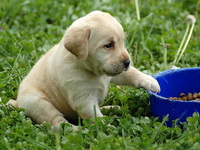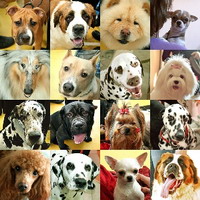Dry food
 Recently, domestic dog owners have an alternative to traditional homemade food. These are finished dry food and canned food for animals. Particularly popular are dry granulated feed. However, the number of their consumers and fans among owners, veterinarians, animal physiologists and dogs themselves is almost equal to the number of opponents.
Recently, domestic dog owners have an alternative to traditional homemade food. These are finished dry food and canned food for animals. Particularly popular are dry granulated feed. However, the number of their consumers and fans among owners, veterinarians, animal physiologists and dogs themselves is almost equal to the number of opponents.
The benefits or harms of dry fodder cannot be said for sure. In Western countries, high-breed animals that grew up and live in nurseries have been receiving exclusively balanced branded food for 10–15 generations.
The undoubted advantage of dry feed is their long shelf life, as well as the convenience and speed of the feeding process itself. The need to chew dense granules has a positive effect on the condition of the dog’s mouth: the teeth are strengthened, cleaned of plaque and tartar, the gums become healthy and do not bleed. In addition, as reported by the manufacturers, ready-made rations contain in their composition everything that is necessary for the growth, development and well-being of the animal. In other words, the owner does not need to carefully weigh and select all the necessary elements in the necessary proportions – they are already contained in finished products.
Currently, the range of dry feed is extremely diverse and, depending on the composition and ingredients used and the manufacturing technology, is divided into 3 classes: “economy”, “premium” and “superpremium”. The most expensive and preferred are super premium class feeds that are made from high-quality products and are best absorbed by animals. The basis of a full-fledged diet is a complex of essential amino acids, vitamins, minerals, trace elements, as well as omega-3 and omega-6 polyunsaturated fatty acids, which ensure healthy skin and the appropriate type of wool.
Given the different purchasing power of dog owners and the taste preferences of animals, firms often produce all 3 classes of feed. For example, Purina offers an economy class line of feeds called Darling; “Premium” class – called “Dog Chow” and “Super Premium” class – called “Pro Plan”. Under the same brand are offered feed “Frieskies”, called the “commercial option.”
Formulas of food class “superpremium” most fully take into account the peculiarities of the organism of the dog, in particular, such as:
– age (dry milk replacer for suckling puppies, Puppi and Junior series for puppies and young animals, Adult series for adult dogs, and Senior series for dogs older than 8 years old);
– weight in the adult state (food for small breeds weighing up to 10 kg; for medium breeds weighing from 11 to 25 kg; for large breeds from 26 to 44 kg, for giant breeds weighing over 45 kg);
– physiological features (feed for pregnant women and lactating females, food for neutered males and sterilized bitches, low-calorie food for dogs prone to obesity);
– food preferences (special food with enhanced flavor, satisfying the appetite of the most demanding and fastidious dogs);
– health (special medicinal food – for example, for dogs prone to food allergies, for dogs with sensitive stomachs, and kidney diseases);
– the degree of activity and physical activity (special high-calorie food for hunting, sporting and working dogs).
For small puppies (under the age of 5 months), buy food from the “Puppi” series, for teenagers and young dogs up to 1.5–2 years old – from the “Junior” series. Getting acquainted with the composition of high-grade concentrates, pay special attention to the content of proteins and fats. In high-quality puppy food there is about 30% of raw protein, with at least 2/3 of this amount – high-quality proteins of natural meat. The percentage of fat is not more than 20%, which creates optimal digestibility of the feed. Foods with a higher percentage of fat are stored very briefly and deteriorate rapidly during storage.
Puppy food is high in calories. It can be said energy in a concentrated form. With very high energy requirements, the baby’s digestive system is very limited, so high-quality puppy food contains proteins that are specially selected for the principle of high digestibility. Foods of the “economy” class, with their low price, are of the lowest quality and contain only 4% of high-grade meat protein. The main part of the protein in such feed is meat and bone meal and soy protein.
Veterinarians know that a dog’s chair is one of the best indicators of product quality. If the dog absorbs food well, the amount of excrement will be small, and the feces will be dense and formed. Low quality protein is poorly digested and passes quickly through the intestines, resulting in a soft (mushy) stool with an unpleasant odor or even diarrhea.



